Owning a horse in the Middle East means dealing with hot and humid weather, which provides the ideal habitat for bacteria and fungi, especially during the summer months. Unfortunately, I’ve found myself struggling multiple times with my horse’s delicate eyes. He experienced three different eye ulcers within the same year. As a result, I conducted online research to uncover possible causes, treatments, and, even more importantly, ways to prevent ulcers from recurring.
I also conducted thorough research on the best equine eye protection products available on the market, which I have listed at the end of this article.
While reading this blog post, please keep in mind that I’m not a veterinarian, and you should never substitute the information provided here for a veterinary consultation. This article is intended to raise awareness about the topic of eye ulcers in horses. In any case, the best advice I can offer is to promptly contact a veterinarian if you observe your horse experiencing eye pain, itchiness, or sensitivity to light.
In this article, I will provide you with comprehensive information about eye ulcers in horses, ranging from potential causes to the best products available on the market for protecting your horse’s eyes. Let’s begin by defining what an eye ulcer is and why it is so common in the Middle East.
What is an eye ulcer or corneal ulcer?
An eye ulcer in horses, also known as a corneal ulcer, is a painful and potentially serious eye condition that can affect humans and most animals, including horses. It involves damage to the cornea, which is the clear, outermost layer of the eye responsible for protecting the underlying structures and aiding in the focusing of light on the retina. Microbial infections are common complications associated with corneal ulcers in horses. When the cornea is damaged, it creates an opportunity for bacteria or fungi to enter the eye and infect the affected area.
What are the most common causes of eye ulcers in horses?
Sadly, eye ulcers can be caused by many different factors including:
– Trauma: Foreign objects, such as dirt, debris, or plant material, create tiny corneal abrasions, which, if left untreated, can develop into full-blown ulcers. Horses can easily sustain eye injuries from various sources, including branches, hay, or even their own hooves. Have you ever seen your horse scratching his eyes on whatever he finds available at the moment? By doing that, they can by mistake cause themself a corneal trauma. Yes, apparently horses are not the best at taking care of themself. Infections: Bacterial, fungal, or viral infections can lead to corneal ulcers. These infections can be introduced through trauma or may result from pre existing eye conditions.
– Abnormal eyelid or eyelash anatomy: If a horse has eyelid abnormalities or misdirected eyelashes (known as distichiasis), they may rub against the cornea and cause ulcers.
On the side, there are also some other elements to consider that may increase the probability of developing eye ulcers:
– Dry eyes: Horses with a decreased lacrimation do not produce enough tears to enable that self cleaning effect that is fundamental to keep the eyes protected by external agents.
– Environmental factors: While there is no direct link between humid weather and the development of corneal ulcers, Constant exposure to harsh environmental conditions, like wind, dust, and UV radiation, can indirectly contribute to the development of corneal ulcers. In the arid landscapes of the Middle East, characterized by intense sunlight, humid and dusty air, can cause horses to squint or rub their eyes, increasing the chances of trauma. Insects, like flies, can also be more prevalent in hot, humid conditions, and their presence can contribute to eye irritation and potential injuries.
How to diagnose eye ulcers in horses
Recognising symptoms:
It all starts with observing your horse carefully in any potential change in their behavior or in the appearance of their eyes. Luckily it is quite easy (at least it always was for me) to understand that something is wrong with your horse’s eye. You may easily notice:
– Squinting or keeping the affected eye closed.
– Excessive tearing or discharge from the eye.
– Cloudiness or opacity of the cornea.
– Redness and inflammation around the eye.
– Sensitivity to light (photophobia).
– Rubbing or scratching at the eye.
– Decreased appetite or overall discomfort.
From my personal experience I learned that if you notice any of the symptoms listed above it is always better to call the vet immediately instead of waiting to see if it solves by itself.
The vet examination:
A veterinarian will normally define this an emergency situation, so don’t get scared if they will be ready to come to visit you asap. This is clear evidence of how important it is to take immediate action when suspecting eye ulcers in horses. The doctor will normally perform a thorough eye examination, which should include the use of fluorescein stain to highlight the damaged area of the cornea. They will apply a few drops of fluorescein dye onto the surface of the eye. This dye adheres to damaged corneal tissue and appears green under a blue light. The stain will help identify the extent and location of the ulcer. The vet will also look for signs of inflammation, redness, and tearing, all of which are common symptoms of a corneal ulcer.

This is how the eye affected by an ulcer will appear after the stain. You can clearly observe the ulcer developing on the surface of the cornea.
To determine if there is a bacterial or fungal infection, the vet may collect a sample from the ulcer using a sterile swab or scraping instrument. This sample is then sent to a laboratory for microbial culture and sensitivity testing. The culture identifies the specific microorganism responsible for the infection, while the sensitivity test determines which antibiotics or antifungal medications are most effective against the pathogen.
Once the veterinarian has gathered all relevant information from these diagnostic steps, they can make a more precise diagnosis and prescribe appropriate treatment. Depending on the severity of the ulcer, the available resources at the stable, and the ability of the owner or stable staff to administer the advised treatment, the doctor will decide whether it is best to treat the horse at the stable (on-farm treatment) or at a veterinary hospital.
Corneal ulcers: Bacteria infection vs fungal infection
Bacterial-infected and fungal-infected corneal ulcers in horses exhibit key differences in terms of their characteristics, treatments, and potential challenges.
Bacterial infections of the cornea often manifest with symptoms such as increased ocular discharge, inflammation, and a yellowish color to the discharge. The ulcer may have irregular margins and may appear to be “melting” or liquefied. After performing a microbial culture, the vet will prescribe topical antibiotics effective against the specific bacteria causing the infection. When detected early, bacterial ulcers can often be effectively treated with appropriate antibiotics. However, if not adequately treated, they can progress rapidly and lead to severe complications, including corneal perforation.
On the other hand, fungal infections of the cornea may have a slower onset compared to bacterial infections. Symptoms are quite similar to bacterial ulcers, except for the presence of a branching or filamentous appearance within the ulcer, which is characteristic of this type of infection. Fungal corneal ulcers are typically more challenging to treat than bacterial ulcers. Treatment involves antifungal medications, such as topical antifungal drops or ointments, which may need to be applied frequently and over an extended period. The choice of antifungal agent depends on the specific fungal pathogen identified through laboratory testing. Fungal ulcers often require hospitalization since they often demand close monitoring and follow-up care.
What are the best horse eye ulcers treatments?
Treating a corneal ulcer in a horse involves a combination of medication, management practices, and close monitoring. While the exact treatment plan may vary depending on the specific case, there are some common practices to follow.
The vet will administer topical antibiotics for bacterial ulcers or specific antifungal medications for fungal ulcers. In some cases, they may decide to include anti-inflammatory drugs and painkillers if the horse is experiencing significant distress. Medications are applied frequently, sometimes as often as every hour. The frequency decreases as the ulcer heals.
In certain cases, the veterinarian may need to debride (remove) damaged corneal tissue to promote healing. This procedure is typically performed under sedation or anesthesia.
Throughout the treatment, it’s essential to maintain a clean, dust-free environment. Using a fly mask or eye shield to protect the eyes from direct sunlight is crucial, especially if the ulcer causes photophobia. Some horses may require protective covers or partial eyelid sutures.
The duration of treatment depends on the severity and the type of infection present. Mild ulcers may heal in 5-7 days, while severe cases may take several weeks.
Here is an image of what the ulcer on my horse looked like after 14 days of treatment:
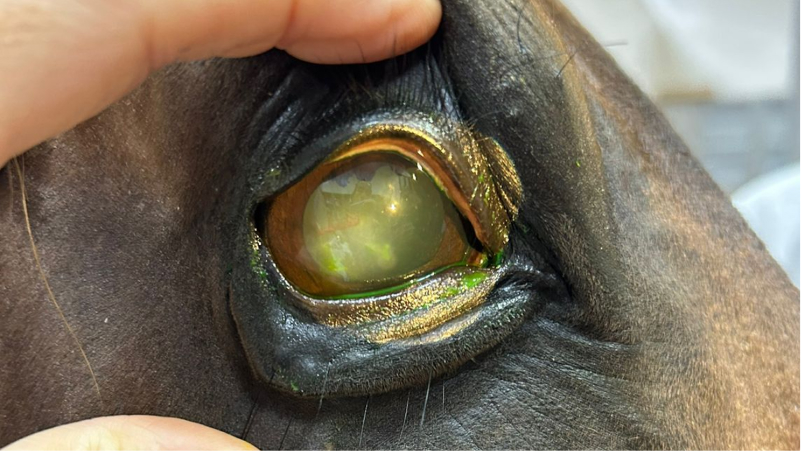
On farm-treatment
Horses with minor corneal ulcers that are small, superficial, and not associated with complications can often receive treatment at the stable. These cases may respond well to initial on-farm treatment. If a veterinarian can provide regular on-farm care, including medication administration and frequent follow-up examinations, you may opt for stable treatment.
In my experience, I would ensure that the horse is not constantly exposed to environmental irritants such as wind and dust before deciding whether it’s best to transport the horse to a hospital or not. Some horses, like mine, may be more challenging to treat. In cases where the horse does not readily allow for the easy administration of topical medicines, choosing to hospitalize the horse would be a responsible choice to ensure effective treatment.
However, I understand that hospitalizing a horse can incur high costs, and sometimes it’s not a matter of choice but necessity. That’s why I recommend carefully considering your decision before acquiring a horse.
One undeniable truth, especially with horses, is that you will never know when something unexpected might occur. As a horse owner, you have a duty to provide the best care for your horse, especially in cases like these where a simple scratch on the cornea could result in your horse losing its eyesight. In this article, I have diligently listed every cost related to horse ownership. Of course, I did not include emergency costs, as those depend on the nature of the emergency, but you can gain a comprehensive overview of nearly every other expense.
If you decide to treat the horse on the farm, you may find this video very useful. It demonstrates best practices for performing eye wash on horses, and some of the tips can be applied to administering drops or ointments.
Horse eye ulcers hospitalization
Horses with severe or deep corneal ulcers, those that have led to significant ocular complications like descemetoceles, or ulcers associated with a high risk of perforation are typically best treated at a veterinary hospital with specialized equipment and expertise.
Hospitalization can be particularly beneficial for horses experiencing severe pain due to the ulcer, as it allows for more effective pain management in a controlled environment. Additionally, cases involving corneal ulcers that require frequent monitoring, complex medical treatments, or specialized diagnostics may also benefit from hospitalization.
In situations where it’s necessary to administer topical medication every hour or at short intervals, a vet may utilize an eye catheter, also known as a subpalpebral lavage system. This catheter is employed to deliver medications directly to the eye’s surface over an extended period. Typically, it consists of a small catheter or tubing that is surgically inserted through the upper eyelid, passing beneath the skin of the eyelid and exiting just above the eye. The tubing is then secured to the horse’s head using a specialized clip or bandage.
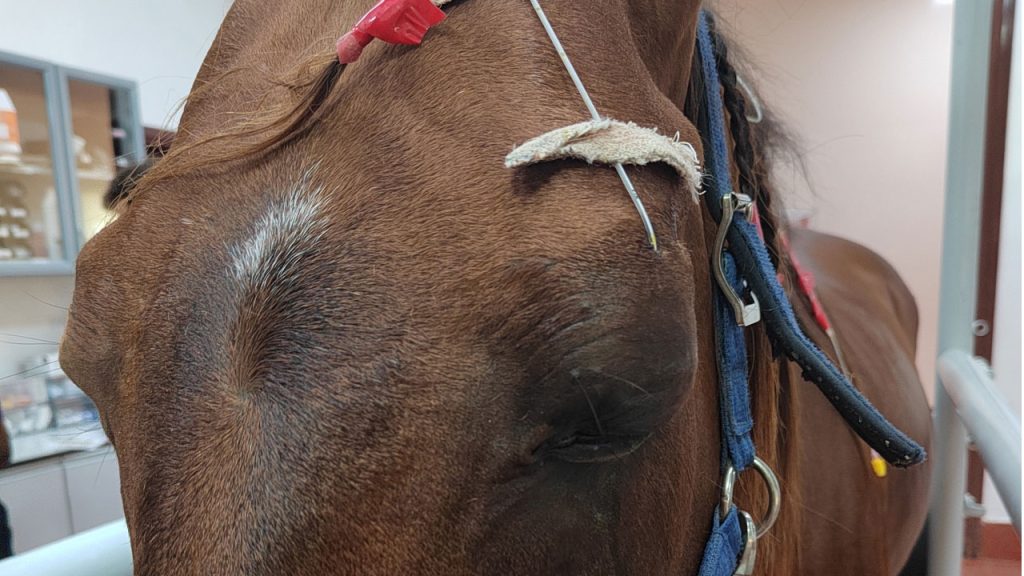
Occasionally, there may be instances where the catheter is not well accepted in the upper eyelid or becomes infected. In such cases, the vet may opt to proceed with a lower eyelid placement.
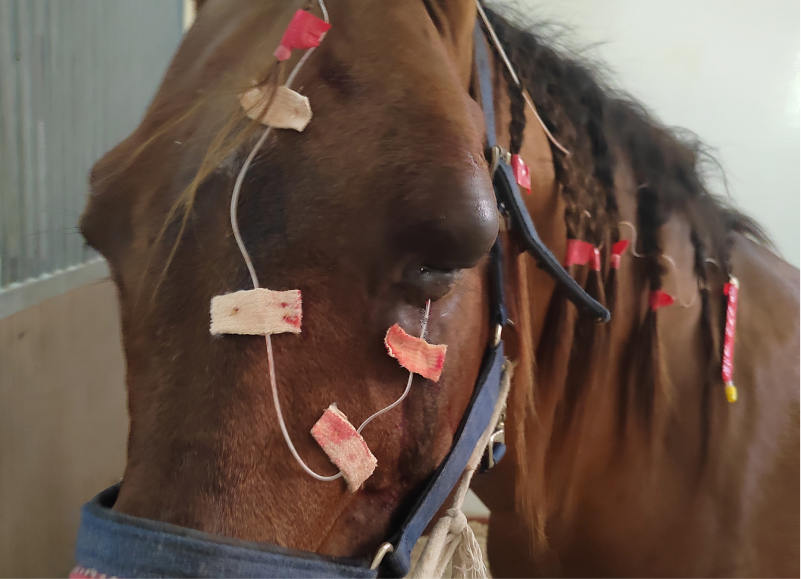
In this picture, you can observe a bottom eyelid catheter applied after the upper eyelid became infected, resulting in significant swelling of the eye.
Based on my previous experiences with eye ulcers, I have consistently chosen to entrust my horse to the care of veterinarians and have him hospitalized. Yazan is stabled outdoors in an environment that is inevitably windy, humid, and dusty. Managing to administer topical treatment every 2 hours, as required, or preventing him from rolling on the sand would have been extremely challenging for me. For these reasons, along with the severity of the ulcers he has experienced, I have always opted for hospitalization.
Which hospital to go to in the UAE to treat equine eye ulcers?
I personally decided to bring him to Sharjah Equine Hospital, where various doctors provided excellent care each time. I received daily updates on his condition, and in all cases, I received back a completely healed horse. Alternatively, you can also consider Dubai Equine Hospital, although I don’t have personal experience with them, so I can’t provide additional information.
Regarding the costs of hospitalization for eye ulcer treatment, there are numerous factors to consider, and I can only share what I personally know. In my case, Yazan was hospitalized for 14 days during his first treatment and for 20 days during the second treatment. The total cost for each hospitalization, which included highly frequent topical treatments with an eye catheter for 10-12 days on both occasions, along with 4-5 weekly checks with fluorescent stain, painkillers, and boarding, amounted to approximately 9,000-10,000 AED each time. I understand that this may sound like a substantial amount, and it indeed is, but in both cases, I highly valued having my horse return to me completely healed and pain-free.
How to prevent horse eye ulcers from recurring
I’ve come to realize that my past experiences have taught me that the best way to deal with an eye ulcer is to establish a solid prevention plan. While it’s impossible to guarantee 100% that your horse won’t inadvertently harm its eyes again or avoid rolling in sand, which can make their eyes dry and dirty, there are some tips I’d like to share, especially if, like mine, your horse has very sensitive eyes.
Proper eye care and management are critical for safeguarding these sensitive animals, particularly in challenging environments like the UAE desert. Effective eye care entails regular eye examinations and implementing measures to minimize exposure to irritants and allergens.
Clean and safe stalls and paddocks
Horses spend a significant amount of time in their stalls or paddocks. Therefore, it’s crucial to ensure that these areas are kept clean and free of any sharp objects or protrusions that could potentially lead to eye injuries. Remove any debris or wire fencing that might pose a risk to your horse’s eyes. Additionally, it’s advisable to closely monitor your horses when they are at play in the paddock. If possible, replace the halter with a clean fly mask to provide constant eye protection.
I personally wouldn’t leave my horse’s eyes unprotected, especially during paddock time. There are numerous options available on the market to keep your horse’s eyes comfortable. I’ve compiled a list of the best equine products I found available.
You can explore a wide range of eye protection products on websites like protectivepetsolutions.com, where you’ll find various options to consider.
Fly masks with UV protection
One effective and cost effective measure to protect your horse’s eyes is to use fly masks equipped with UV protection and soft mesh screens. These masks serve the dual purpose of shielding the eyes from insects and harmful UV radiation. Additionally, fly masks can provide a barrier against foreign objects that might otherwise enter the eyes.
I personally came across this UV fly mask on Amazon, but there are numerous variations available that you can also find at tack shops in the UAE. These masks are a valuable addition to your horse’s protective gear, especially in areas with high sun exposure and insect activity.
Equine visor with UV protection
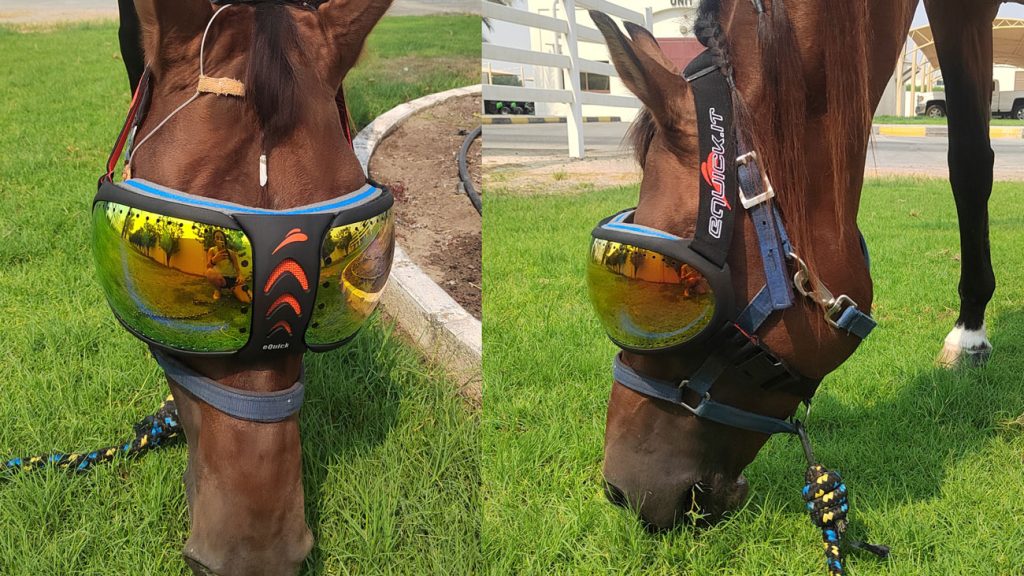
This remarkable visor for horses is designed to provide protection for the eyes against various external factors, including harmful UV rays. Depending on the lens color you choose, you can benefit from more than 90% UV filtering with black lenses or 2% with transparent ones.
The visor is intended to be worn by the horse only under supervision, such as during hand walks, training sessions, and riding. It easily accommodates any horse, and in the picture above, you can see my Arabian horse wearing it. It can be readily adjusted to fit any horse comfortably.
For Yazan, I opted for the orange lenses, which filter 44% of the light and seem to be ideal for sunny days and sunset rides.
You can find the Evysor available for purchase from various sources that deliver to the UAE, starting with eQuick.it, the manufacturer’s website. Other options include Tosoni Selleria, where I acquired mine (with a delivery time of just 3 days from Italy to Dubai), Equizoneonline.com, and several others.
It’s worth noting that I couldn’t locate this product in local Dubai shops, so you may need to wait for delivery when ordering it. Nonetheless, the protection it offers to your horse’s eyes is invaluable.
Protective hoods and goggles
Given the delicate nature of the visor and its unsuitability for paddock time, I searched for alternative products to protect against rubbing and interaction with other horses. I came across some impressive goggles with a sturdy metal mesh that are originally designed for racing but serve this purpose excellently as well.

I purchased this product from Aliexpress at a reasonable price of only 100 AED, and it was delivered in 15 days. You can also find the same product on ejwicks.co, albeit at a slightly higher price, with the benefit of potentially faster shipping if you need it urgently. Additionally, I found the same product available on Desertcart.com.
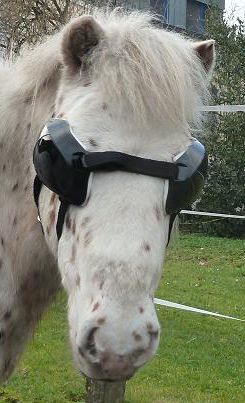
For those seeking smaller eye goggles that still provide UV protection like the Evysor, these goggles could be a suitable alternative.
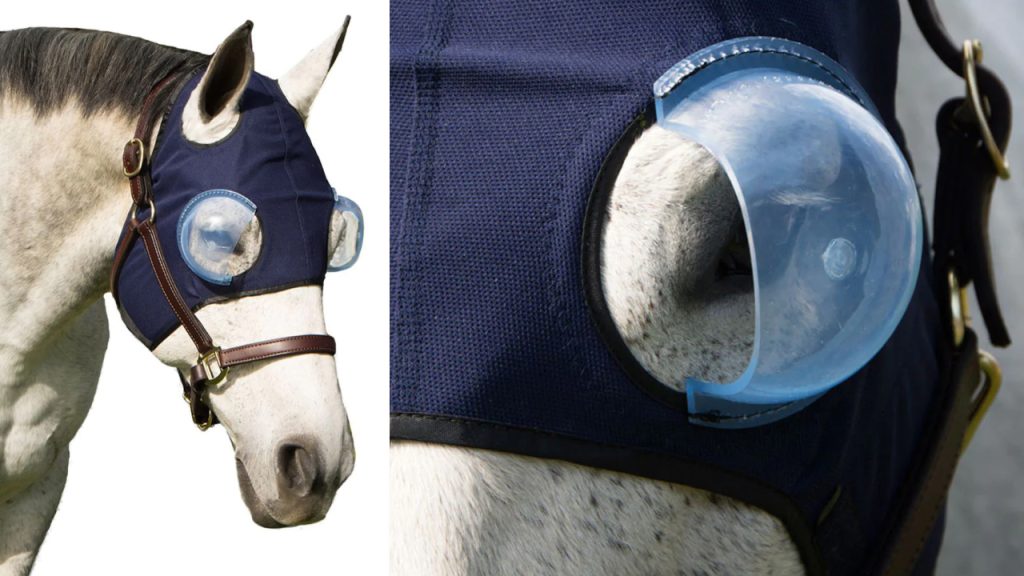
One last solution that I struggled to find in stock when making these purchases is the incredible horse medical hood by Intrepid (I already have a bareback saddle pad from Intrepid that I adore). This hood is explicitly designed to safeguard the horse’s eye during ongoing treatment to expedite the healing process or as an additional precaution to minimize further eye injuries.
As I found it mostly out of stock on numerous websites, here are alternative stores where it might be available: Eaglewoodequestrian.ca, Outlawtack.com, Statelinetack.com and Gritroutdoors.com. These sources could potentially have this visor in stock but also so much more to help you protect your horse from eye ulcers.
Eye wash and cleaning

In addition to valuable add-ons to your horse’s tack, it’s essential to prioritize keeping your horse’s eyes clean and hydrated, particularly after rides in the desert. My final product recommendation pertains to this eye irrigating solution from Farnam.
Clear Eyes is a sterile eye wash that assists in flushing away dust and debris and can be safely used on sensitive eyes. This product can be an invaluable addition to your horse care routine, helping to maintain your horse’s eye health, especially in challenging environments like the desert.
This is pretty much all you need to know about eye ulcers in horses.
In our journey through the world of equine eye ulcers, we’ve learned a lot about these painful and vision-threatening conditions. Treating an eye ulcer in a horse may require so much patience, care and a bit of hope that everything will be allright. Horse eye ulcers are a pretty scary experience from the horse’s owner perspective. However, the good news is that prevention is the best medicine. By maintaining a safe environment, managing irritants like dust and flies, and conducting regular eye check-ups with your vet, you can significantly reduce the risk of eye ulcers.
Our horses rely on us to keep their eyes healthy and bright. With knowledge, vigilance, and a touch of tender loving care, you can help ensure that your equine friend enjoys a lifetime of clear vision and the beauty of the world around them.


